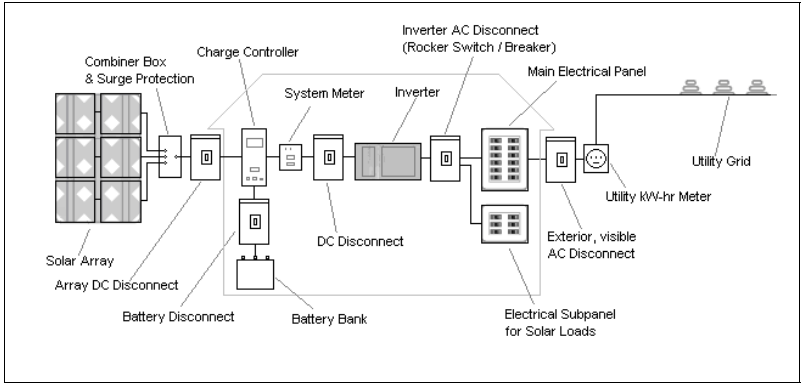Photovoltaic system types can be broadly classified by answers to the following questions:
- Will it be connected to the utility’s transmission grid?
- Will it produce alternating current (AC) or direct current (DC) electricity, or both?
- Will it have battery back-up?
- Will it have back-up by a diesel, gasoline or propane generator set?
Here we will focus on systems that are connected to the utility transmission grid, variously referred to as utility-connected, grid-connected, grid-interconnected, grid-tied or grid-intertied systems. These systems generate the same quality of alternating current (AC) electricity as is provided by your utility. The energy generated by a grid-connected system is used first to power the AC electrical needs of the home or business. Any surplus power that is generated is fed or “pushed” onto the electric utility’s transmission grid. Any of the building’s power requirements that are not met by the PV system are powered by the transmission grid. In this way, the grid can be thought of as a virtual battery bank for the building.
Common System Types – Most new PV systems being installed in the United States are grid-connected residential systems without battery back-up. Many grid-connected AC systems are also being installed in commercial or public facilities.
The grid-connected systems we will be examining here are of two types, although others exist. These are:
- Grid-connected AC system with no battery or generator back-up.
- Grid-connected AC system with battery back-up.
Example configurations of systems with and without batteries are shown in Figures 1 and 2. Note there are common variations on the configurations shown, although the essential functions and general arrangement will be similar.
Is a Battery Bank Really Needed? – The simplest, most reliable, and least expensive configuration does not have battery back-up. Without batteries, a grid-connected PV system will shut down when a utility power outage occurs. Battery back-up maintains power to some or all of the electric equipment, such as lighting, refrigeration, or fans, even when a utility power outage occurs. A grid-connected system may also have solar generator as the back-up if the facility cannot tolerate power outages.
With battery back-up, power outages may not even be noticed. However, adding batteries to a system comes with several disadvantages that must be weighed against the advantage of power back-up. These disadvantages are:
- Batteries consume energy during charging and discharging, reducing the efficiency and output of the PV system by about 10 percent for lead-acid batteries.
- Batteries increase the complexity of the system. Both first cost and installation costs are increased.
- Most lower cost batteries require maintenance.
- Batteries will usually need to be replaced before other parts of the system and at considerable expense.


